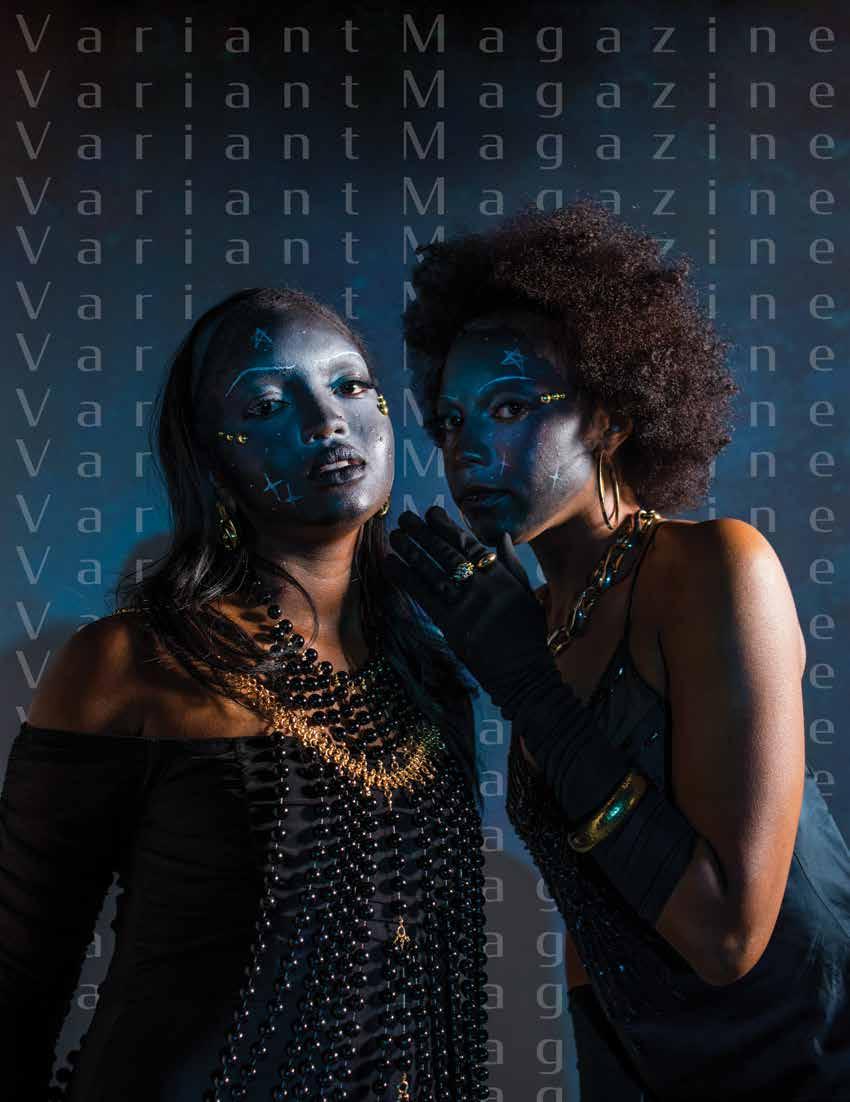




Russian American theoretical physicist Andrei Linde once said: “It was never easy to look into the future, but it is possible and we should not miss our chance.” As a publication, we strive to be forward-thinking, to push boundaries and to focus on progression. This was our chance.
Futurism, by defnition, is a point of view that fnds meaning or fulfllment in the future rather than in the past or present. Futurism, by VARIANT’s defnition, is a jab at the unknown. Throughout this issue, we propel readers to explore the future, the unknown. Though however scary the unknown may feel, we produced this as a reminder to always take risks, as risks are often undiscovered opportunities – possibilities to learn, to grow, and to exist, without limitations.
Over the last 11 weeks of production, we addressed themes of technology, from applications of virtual reality (pg. 7) to the robotic vision of Alexander McQueen’s 1999 runway designs (pg. 15).

We also recognized that we should not look into the future unless we frst learn from the past. Retrofuturism, a creative art movement of the 60s, imagined what the future might look like. Our comic book-style, Barbarella-inspired photoshoot on page 1 is accompanied by the work of style writer Emma Bhatt, who tackles why “fashion, which has often been written off as a topic of interest for shallow women, is communication, is culture, is power.” Delving deeper into the past, our Black Stars photostory draws inspiration from Afro-Futurism (pg. 29). Infuenced by the African American cultural experience with stars — namely, using the sparkling foreign bodies to fnd their way to freedom — our photo story is an exaggerated play on reality and fantasy; we depicted our models as the ephemeral beings in the sky who, perhaps, have always been our ancestors leading us into the future.
We further traversed the questionable fate of our futures through the images of communal survival amidst post-apocalyptic nature, societal subversion, and the abandonment of socioeconomic groups during technological advancements.
On our fnal pages, you’ll encounter a powerful op-ed (pg. 51) on the future of transgender people
in the fashion industry, written by OU student and transgender model Carmen Szukaitis. “This is not a story of confict and victimhood; it is one about resilience, success, and the importance of recognition,” she writes, while educating readers how visibility is the most important aspect to her future, and the future of all transgender models, in the fashion world.
Teeming with both grim realities and hopeful endeavors, VARIANT’s fall ‘22 issue aimed to pioneer thoughtful action. Though some topics were heavy, our hearts are light and full of hope. Needless to say, every day of production for us was an opportunity to learn and to grow. Though I encourage us all to forever dream, we’re not always promised a tomorrow. So, let’s not miss our chance to build the future, now.
As you read this issue, I ask that you refect on the past and advocate for the best future for all. On behalf of the VARIANT team, thank you for your support and dedication. I hope you enjoy consuming our art as much as we enjoyed creating it.
Marguerite AugierSincerely,
Marguerite AugierEDITOR IN CHIEF EXECUTIVE EDITOR ASSOCIATE EDITOR

CREATIVE DIRECTOR
ART DIRECTOR MADISON BAILEY
CHIEF OF PHOTOGRAPHY EMMA FRIEND
PHOTOGRAPHERS ANNA MARTHE, ELLA SPREMULLI, SOPHIA PARRILLO, THEO MCCUDDEN, MEREDITH VIOX, JOEY EARLEY, SYDNEY BRITTON
PHOTO EDITOR MADELINE MELRAGON
WEB EDITOR MAX ABBATIELLO
HEAD OF DIGITAL TECH EVIE SEARS
PUBLICATION DESIGN DIRECTOR EMILY ALLEN
PUBLICATION DESIGN ASSOCIATE MADDIE JAMES
DESIGNERS EMMA FRIEND, ABBY LINDLEY, AUBREY CLINE, NEVADA FISH, NIVI CHAWDA, REEBHA CHETTY, TAYLOR STRNAD
HEAD OF MAKEUP JACK WILBURN
MAKEUP ARTISTS BEA TRAUM, ALLIANNA TARANGO, SOPHIA PARRILLO, ALEXIS KY RODRIGUEZ, LEILANI STILLWAGON, SHEA O’FLAHERTY, JAICÉE JEFFERY, MEREDITH VIOX, MARGUERITE AUGIER, CYDNEE LIVINGSTON
TREASURER TAYLOR STRNAD
MARGUERITE AUGIER ANNA BIRK BEKAH BOSTICK CYDNEE LIVINGSTON
COPY CHIEF MADISON KOPP
WRITERS EMMA BHATT, KATE TOCKE, PARIS WEEMS, CARMEN SZUKAITIS, MAGGIE MALONE, RILEY BROWN, NEVADA FISH
HEAD OF VIDEOGRAPHY OLIVIA LUTZ
VIDEOGRAPHERS MEREDITH VIOX, SOPHIE HINER, LILITH ROBERTS, SOPHIA PARRILLO
HEAD OF STYLING KATIE JOHNSON
STYLISTS ALLIANNA TARANGO, DEVON WHITE, HALI BRIDGES, SOPHIE HINER, NORAH LEFLORE, SHEA O’FLAHERTY, ERIN BAUMANN, LAURA KAMPER, ELLA MUSTO, MARGIE BEHRENS, KINGA TUROCZI, LONDON FLORES, SOPHIA NOLL, KY RODRIGUEZ, SAMANTHA NAYLOR, ELLA KUKIELA, BLAIR FORRESTER
HEAD OF EVENT PLANNING ELLA CALHOUN
HEAD OF PUBLIC RELATIONS ABBY LINDLEY

PUBLIC RELATIONS ASSOCIATE SAMANTHA SCHIMMOLLER
PUBLIC RELATIONS ERYN EWING, TAYLOR STRNAD, RILEY BROWN, SOPHIA NOLL, ALYSSA GOODENOW, AUBREY CLINE, ELLA KUKIELA, LONDON FLORES, RAYA FALL
Raya Fall, Tahji’Avieè Crumpler, Lily Sciuli, Joey Earley, Devon White, Sophia Almanza, Jaicee Jeffery, Kenji Smith, Elise Wrage, Katie Tocke, Allianna Tarango, Laura Kamper, Samantha Naylor, Leilani Stillwagon, Taylor Strnad, Margie Behrens, Hali Bridges, Campbell Hauschild, Reese Campana, London Flores, Eryn Ewing, Blair Forrester, Rosie Mogford, Salma Zerhouane, Marguerite Augier, Taylor Jones, Bekah Bostick, Sophia Parrillo, Olivia Lutz, Mimi Calhoun, Nandi Gott, Anna Birk, Madeline Melragon, Josh Dill, Aubrey Cline, Sophie Hiner, Sophia Noll, Genesis Motley, Nevada Fish, Riley Brown, Paris Weems, Shea O’Flaherty, Ky Rodriguez

















 Marguerite Augier Editor-in-Chief
Madison Bailey Art Director
Anna Birk Executive Editor
Abby Lindley Head of Public Relations
Cydnee Livingston Creative Director
Samantha Schimmoller Public Relations Associate
Madison Kopp Copy Chief
Max Abbatiello Web Editor
Bekah Bostick Associate Editor
Marguerite Augier Editor-in-Chief
Madison Bailey Art Director
Anna Birk Executive Editor
Abby Lindley Head of Public Relations
Cydnee Livingston Creative Director
Samantha Schimmoller Public Relations Associate
Madison Kopp Copy Chief
Max Abbatiello Web Editor
Bekah Bostick Associate Editor


















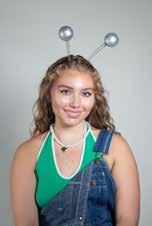
 Emily Allen Head of Publication Design
Maddie James Publication Design Associate
Jack Wilburn Head of Makeup
Katie Johnson Head Stylist
Madeline Melragon
Photo Editor
Emma Friend Photo Chief
Olivia Lutz Head of Videography
Evie Sears Head of Digital Tech
Taylor Strnad Treasurer
Ella Calhoun Head of Event Planning
Emily Allen Head of Publication Design
Maddie James Publication Design Associate
Jack Wilburn Head of Makeup
Katie Johnson Head Stylist
Madeline Melragon
Photo Editor
Emma Friend Photo Chief
Olivia Lutz Head of Videography
Evie Sears Head of Digital Tech
Taylor Strnad Treasurer
Ella Calhoun Head of Event Planning
 - Diana Vreeland
WRITTEN BY EMMA BHATT PHOTOGRAPHED BY ANNA MARTHE
- Diana Vreeland
WRITTEN BY EMMA BHATT PHOTOGRAPHED BY ANNA MARTHE
“Fashion is part of the daily air and it changes all the time, with all the events. You can even see the approaching of a revolution in clothes. You can see and feel everything in clothes.”

In a time when we have the world at our fngertips, the news in a perpetual stream, there lies a wistful desire to “keep politics out” of certain things, to allow for a few precious facets of life to remain untouched by the greater meaning which we imbue on most aspects of daily life. Maybe it would be nice if we just let clothes be clothes. Unfortunately, this is sort of impossible. We can’t stop fashion from being political; fashion has always been political. What we wear serves as a refection of the world around us.
Practical changes have certainly made their mark on the history of fashion, but fashion has also evolved as a more symbolic response to societal changes. At its core, what we wear matters because embedded in the what is always a larger why.

Take, for example, the impact of World War I on women’s fashion. The elaborate styles of pre-war garments were simplifed in an effort to preserve textiles, and the multiple outft changes of an upperclass woman were cut back. The need for women in the workplace also led to changes for working-class
women, allowing for the transition from skirts to pants for women who labored in factories. The national spirit of sacrifce on behalf of the fghting overseas created a general shift in the American attitude toward fashion, ushering in an era which prioritized practicality. The end of the war created its own set of changes in Western fashion. The rise of the fapper girl, the icon of the ‘20s and a symbol of glitz and sexuality, was in many ways a response to the shifting culture. Women gained the vote, speakeasies combatted prohibition dryness—the world was changing
and Americans wanted to have fun.
As the fghting ceased and global communication increased, young people embraced a “life is short” perspective, rejecting the restriction of convention in favor of personal fulfllment.
Additionally, the consumerism which began to dominate both American and European life during this time inspired a sense of individual freedom, which was refected in the fashion of the decade.

As the decade ended in economic collapse, however, the fashy luxury which characterized the twenties
gave way to a new look. The Great Depression saw the introduction of many practical styles, such as dresses made from feed and four sacks. The dresses, made by rural mothers in a bout of resourceful ingenuity, were primarily worn by children.
In an effort to keep the garments fashionable, the dresses were often adorned with beads, buttons, and other embellishments, providing little ways to give poor, farm families a sense of agency over their style. However, the popularization of “the movie star” as a cultural icon allowed for a glimmer of extravagance to remain, keeping the
hopes of luxury alive in the hearts of the American public.
As the second world war dominated the beginning of the ‘40s, fashion was dominated by the air of war, too. The utilitarian style of the decade was partially based in necessity, due to the restriction of materials issued by the American War Protection Board. Still, the attitude of the nation was mirrored in such regulation; dressing down was a way to show good citizenship and to create a sense of national solidarity with the troops fghting abroad. Similarly to World War I, women’s role as laborers brought
the return of pants, particularly denim. However, the end of the war and a desire for return to normalcy encouraged women to give up the pants for a more “feminine” style.
Notably, what is considered “feminine” style has changed drastically throughout history. In science fction media, which became increasingly popular starting in the forties, miniskirts became associated with women of the future. Often paired with tall boots and metallic pieces, these skirts provided a visual representation of the way these space women, more equal to their male counterparts, differed from real-world women. Such looks became a reality, however, upon the popularization of the mini skirt in the ‘60s. Credited to British designer Mary Quant, the miniskirt symbolized a new sort of femininity, one characterized by sexual liberation. As the seventies arrived and the American consciousness
took a turn for the conservative, maxi skirts were introduced as an alternative, though skirt lengths were essentially deregulated by this time.


Still, the hippie fashion of the late ‘60s and early ‘70s showcased a different sort of freedom. Hippie distaste for rigidity was evident in the loose garments which were associated with the fashion. A rejection of capitalist ideology was evident in their mythological inspiration. Folklore inspired fashion refected hippie romanticization of different times, of an ancient and perhaps fantastical world into which they hoped to transform the modern one.
The popularization of hippieinspired fashion in the current day is perhaps indicative of a similar outlook. Crochet tops and patchwork pants represent the possibility for freedom from the over-consumption of late-stage

capitalism. If you can make your own clothes, or thrift them, or trade them with your friends, then maybe you can remove yourself from the environmentally and ethically corrupt fashion of the modern day. This seems to be the mentality of Generation Z as they begin to dominate the world of fashion, using style as a symbol of personal values rather than simply an unconscious refection of the society one exists in.
Such an analysis of fashion is not only interesting—it’s important to right the wrongs of the past. Fashion, which has often been written off as a topic of interest for shallow women, is communication, is culture, is power. If we view fashion as a form of art, then the clothes become the means through which the designer-as-artist engages with the culture—to embrace it, refute it, or transform it.

Today as a society we have become desensitized to the idea of technology and the various forms of it. Over the past few years, there have been a plethora of technological advances, and the effects it has had on our society have not gone unnoticed. I sat down with Ohio University Professor Charles “Chip” Linscott to get his input on virtual reali ty and how it is impacting our culture. Chip teaches a variety of classes on virtual reality theory, history, and production.
QWhat areas of society do we see virtual reality most heavily used in?
“Right now it’s used extensively in training and high end manufacturing to help evaluate employees. [It is] also used a lot in healthcare for simulation and rehabilitation, from the U.S. military to healthcare to tech companies that are interested in how VR can be used to train and educate.”
QWhat are the similarities to our future to shows like “Black Mirror?”
“‘Black Mirror’ is such a smart show. It has a pretty dim view of human nature and global human culture … It’s a show that is generally written to combine advanced technologies with some of the uglier aspects of human beings …“Black Mirror’’ looks at the technology we have now, like artifcial intelligence and virtual reality, and anticipates what things might be like in the near term … It is not as outlandish as some other science fction. A lot of the technologies they look at are kind of here now and need a push to what “Black Mirror” is talking about.”
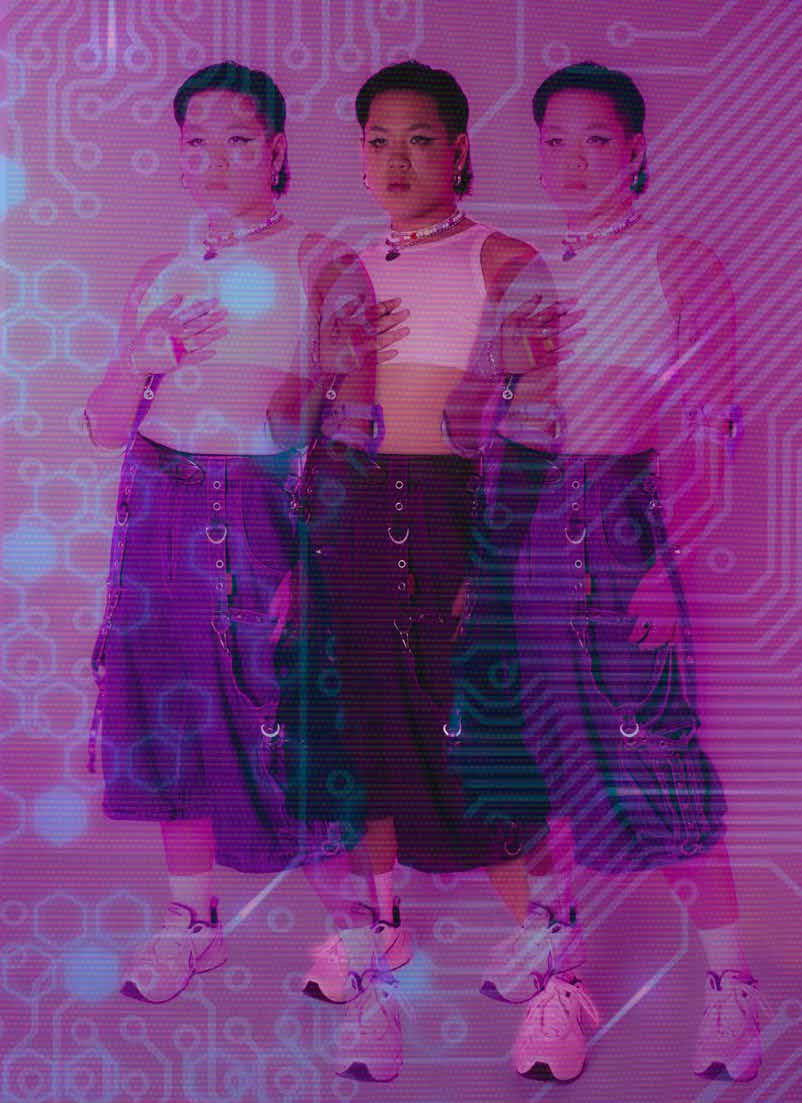
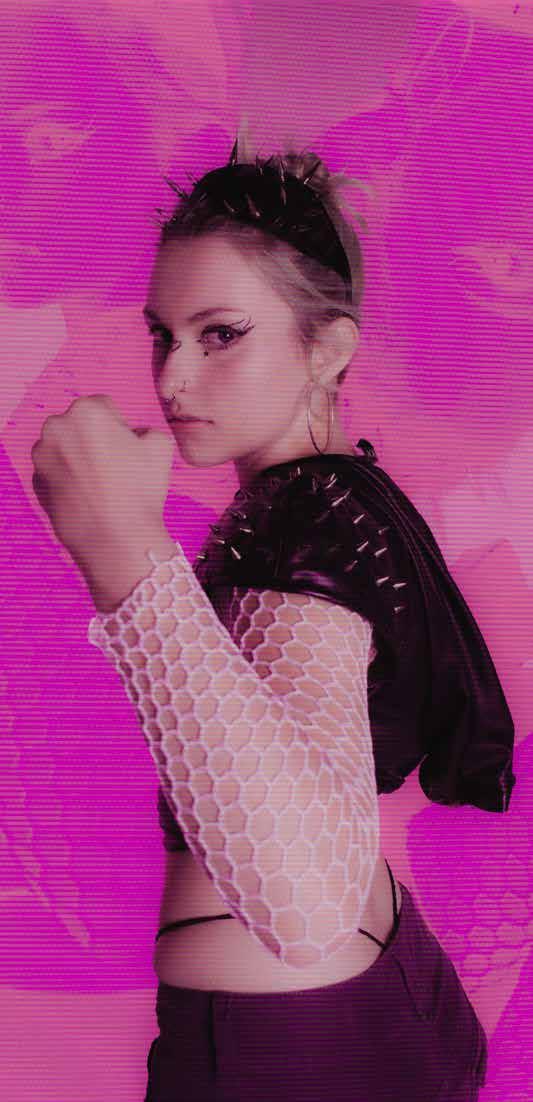

QWhat are your thoughts on virtual reality recently being viewed as a new therapy technique? Do you think people with depression and anxiety can actually beneft from this new form of therapy?
A“Defnitely. I don’t think like most virtual reality applications that purport to take the place of something like talking therapy, that’s a mistake. It is not completely replacing that, like virtual reality education or business meetings are not a threat to people actually sitting in a room together, people going into a classroom together. They are an augmentation … There’s an application called Snow World from the University of Washington that’s been used for decades to help people who have been badly burned go through rehabilitation with far fewer drugs. It reduces the pain that they feel during this rehabilitation during burns. It’s this cooling feeling and your brain is occupied with that. These kinds of applications don’t replace traditional rehabilitation. It just adds to it and helps people not take as many opioids, for example, and feel less pain overall. For counseling, for mental health, it’s a very powerful tool for PTSD … I think it’s an excellent tool for all different types of therapy. The more that people invest their time and research into it, it’s just going to get better and better.”
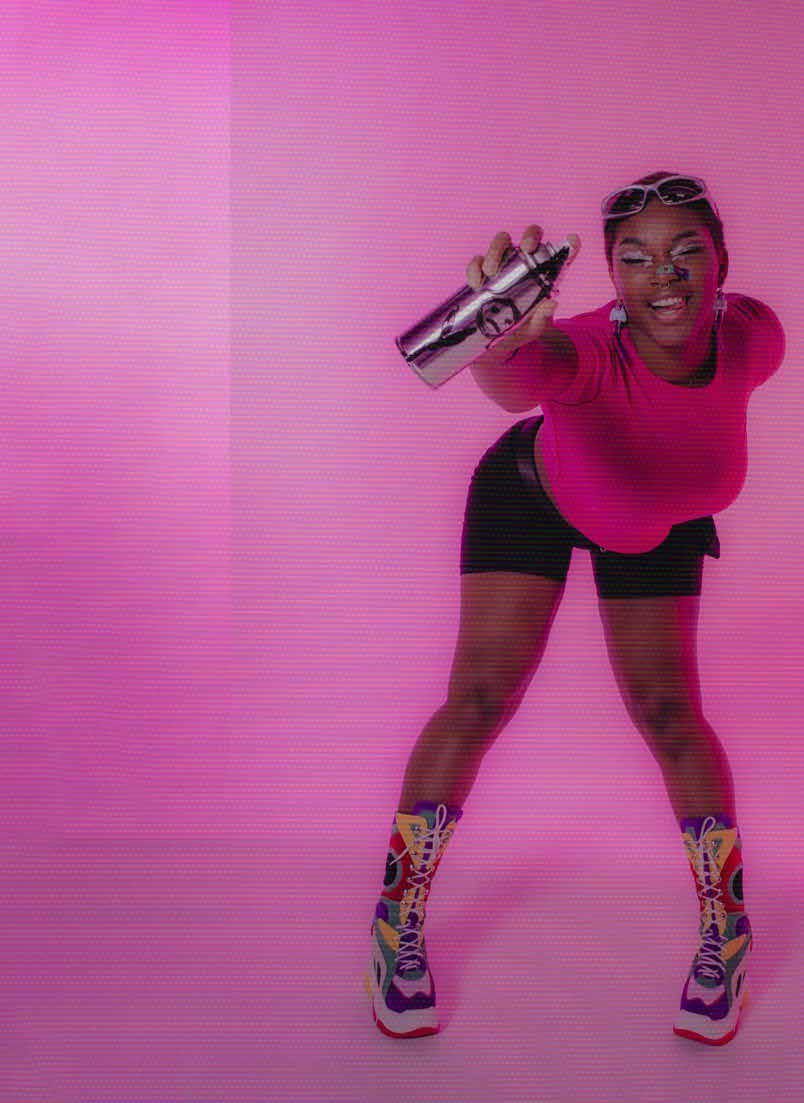

What do you think the dangers of deep fakes are and do you think it will become a big problem in the future? Will we evolve or do you think there will be no progress?
“It is going to be evolving rapidly. We are already at the stage where we have to employ experts to look at videos and say, ‘This is a well done deep fake.’ There are now free deep fake sites where you can go and put in peoples’ images and videos and it will spit out a convincing deep fake. If you are trained in making these simulations, you can make things that fool most people in the general population. When will we get to a point where it’s very diffcult to distinguish a deep fake of any sort from the real thing? Audio recordings can splice together my words in a way to make it sound like something I am not saying. Those are the dangers that will get to the point where you can’t distinguish a deep fake; handwriting, writing style, voice, images we can put together,it’s already a problem in which people are having their images used for things like pornography that they didn’t consent to … Things like rapidly advancing artifcial intelligence and big leaps in computer technology … are just going to make all this easier to do. In the next fve to ten years, it’s going to be really something.”
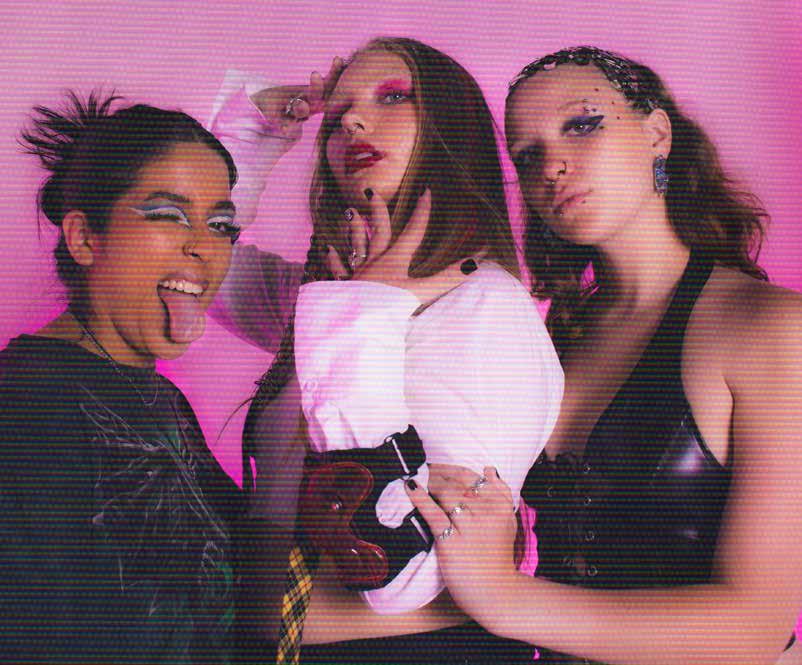
QIn the past couple of years artists have found themselves getting involved in the virtual reality world by hosting holographic concerts. Do you think this specifc experience is classifed as virtual reality and what are your overall thoughts on holographic concerts in general?
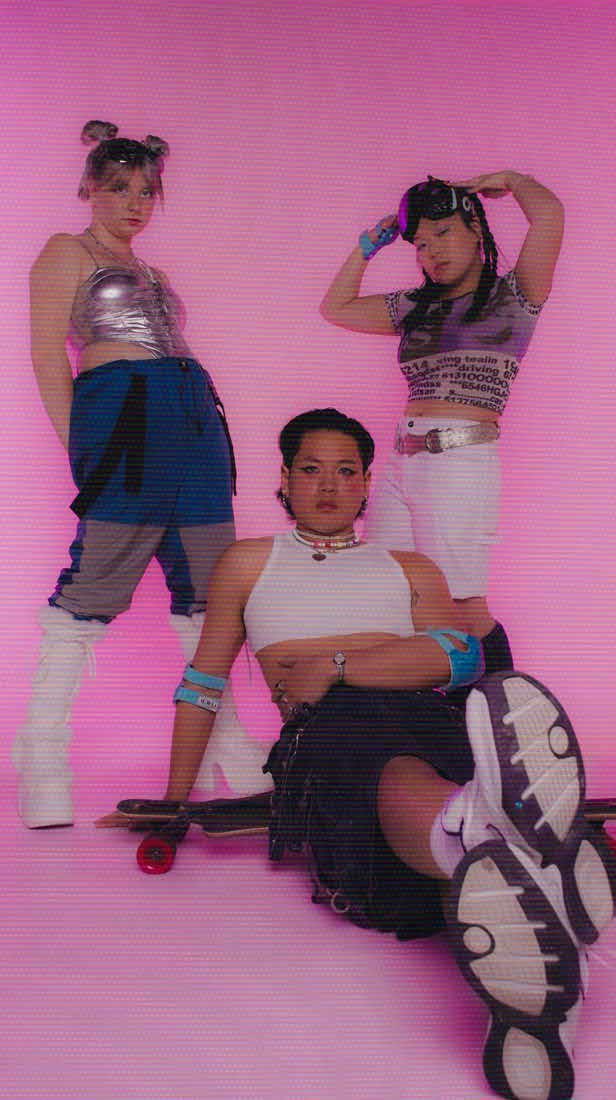
“They’re related to virtual reality but they’re not quite VR. They are defnitely in the same wheelhouse, and I think that it’s really important to talk about. There are a few that are VR, like VR concerts where you wear a headset and you look around and see yourself in an audience and you see the concert on stage in VR. Like Travis Scott’s Fortnite concert – not VR but in the metaverse and an interactive environment where people could go and feel like they were there.
With virtual reality, we need to feel immersed and be present in that virtual world. Holographic concerts would be seen as augmented reality. There are now virtual live concerts and there’s certainly been experimentation with 360o video concerts where you can feel like you’re actually there. As far as holograms go, the connection of virtual reality is that this is a goal that Meta has for the metaverse. You will be able to wear some kind of augmented reality device. The idea is that it will kinda look like eyeglasses but you will be able to see a holographic projection of a friend or loved one who’s not there. One of Meta’s advertising images is two folks playing chess, and one is clearly somewhere else but they are playing chess virtually with a real time hologram with a friend who is half around the world. That’s a goal, that is technology that is being worked on. It is just not available to consumers at this stage.”



 PHOTOS BY SOPHIA PARRILLO
PHOTOS BY SOPHIA PARRILLO


“When I’m dead and gone, people will know that the 21st century was started by Alexander McQueen,” said the designer himself. How did Alexander McQueen go from drawing dresses on the wall at age three to being one of the most controversial designers in the world? Starting off by making dresses for his older sisters, there was never a doubt about where his interests were going to take him.
Stepping into the professional world of fashion in 1985 with Anderson & Sheppard, McQueen became an expert tailor, allowing him to pay intricate attention to his designs. Seven years later, in 1992, McQueen would start his own label. Inspired by performance art and theater, his A/W 1993 collection was inspired by the movie Taxi Driver. Robert De Niro’s character, Travis Bickle, sported a shaved mohawk and had little money, thus the collection consisted of clothes made out of latex, clingflm, and other materials he reused. McQueen’s frst runway show, the 1993 spring/summer collection, named him an “out-of-the-
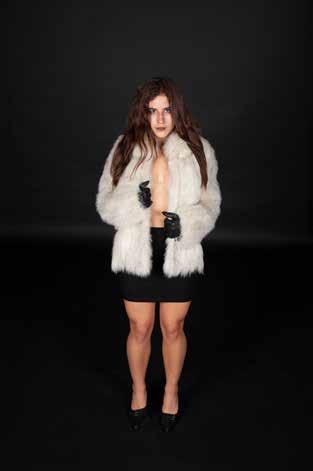
box” designer. He gained popularity for his “bumster” trousers, which are extremely low-rise pants that reveal the skin at the top of the “bum.”
His spring 1999 show would arguably become his most iconic; model Shalom Harlow would walk out in a white dress and stand on a rotating platform. While the platform spun, robotic machines sprayed the dress black and yellow. McQueen stated that the collection’s fnale “was inspired by an installation by artist Rebecca Horn of two shotguns fring blood-red paint at each other.” Harlow would go on to say that she and McQueen had little conversation before the show, as he wanted to give her complete control. “Rewatching it today, it seems like those robots are painting a chaotic, but somehow poetic, version of our current times,” reported Vogue in 2020.

McQueen’s innovative runway show continues to be talked about 29 years later, as Bella Hadid wore a sprayed-on dress at the Coperni show for Paris Fashion Week 2022 – similar to his original idea in 1999. Another look from the show included model Esther Cañadas in a seethrough crystal dress, with a crystalized cage around her head.

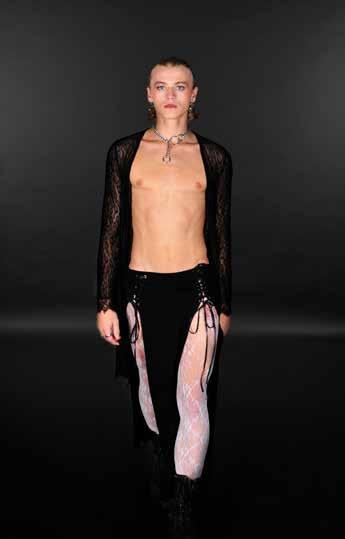
In 2003 McQueen debuted the skull scarf. This scarf became a staple for the Alexander McQueen brand. To McQueen, skulls were a symbol of death and morbidity on runway shows. It was seen on several A-listers of the 2000s and was produced in a number of colors. The scarf was a status symbol. It was such a staple in his career that it was re-introduced in 2013
for the 10-year anniversary, three years after McQueen’s passing.
Later in his career, McQueen created the Armadillo shoe, a 12-inch heel that resembled a claw, which Lady Gaga wore in her “Bad Romance” music video in 2009. Companies, such as Dolce & Gabbana, Gucci and Prada, had designs that were a lot more colorful and mainstream; however, McQueen wanted to be different. He pushed his team through technical challenges as his designs were diffcult to create. McQueen transformed fashion with his nontraditional looks. He explored different themes with powerful messages behind each of his collections. He had a vision of the dystopian
world and would display that in his looks with the help of hair and makeup. McQueen became a major infuence on the look of future runways because his shows were performances. “I’m not interested in being liked,” the designer stated. He wanted to leave an impact on every person who saw his work, whether they enjoyed it or not. Although his life was cut short in 2010, his company was succeeded by Sarah Burton, who had worked with McQueen since 2000. McQueen’s outlandish designs would leave a lasting effect on the fashion industry. Even after his passing, designers and models praise his work for changing the way fashion is portrayed.

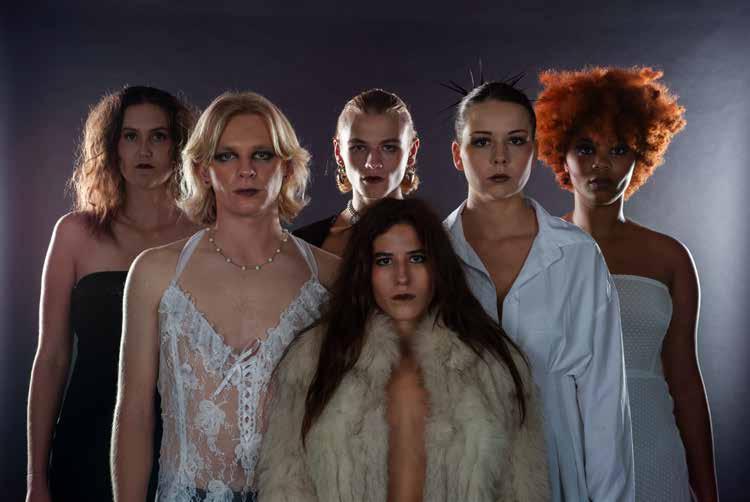


Strolling through college green and seeing the heart of campus beat vigorously with life, it’s hard to imagine a space near Athens where nature isn’t booming with effervescence. However, tucked away in streams throughout Southeastern Ohio, acidic waste pollutes aquatic ecosystems into dormancy. Many once-clear water sources have become muddied orange by toxic sludge from a process known as acid mine drainage, the discharge of acidic water from metal and coal mines
into the environment. Luckily for Athens, Professor John Sabraw is tackling the issue head-on. Sabraw is a professor of painting and drawing at Ohio University. Not only is he an artist, he’s also an environmentalist. For over a decade, Sabraw has worked alongside engineering and environmental studies professionals in order to reclaim the iron oxide found within mine drainage pollution and turn it into paint pigment. The Ohio Department of Natural Resources identifes direct source control, such
as the reclamation efforts carried out by Sabraw and his team, to be the preferred method of mine drainage control as it often can eliminate the problem completely without requiring further maintenance in the future.
Sabraw attained the idea for the project when he attended a program provided by members of the environmental studies department at Ohio University that aimed to teach other faculty members about the environment in Southeastern Ohio.

“That was the frst time I was taken out to an acid mine drainage site,” Sabraw says. He recalls seeing shockingly rustcolored streams. The lightbulb went off when he was told that the deep orange tint was caused by iron oxide. “Most of the paints I worked with my whole life are iron oxides. Throughout history, even the earliest cave paintings drawn from red ochre, it’s all iron oxide,” Sabraw explains. He took a sample of iron oxide from the site and tinkered with it in his studio, but his frst trials emerged fruitless.
Though a seemingly lost cause, one of Sabraw’s friends connected him to Professor Guy Riefer, an engineering professor at Ohio University. Riefer was searching for an artist to help him make paint pigment, which happens to be a process that Sabraw has taught to his students for years. Over coffee, the two found that they were trying to accomplish the same goal and decided to join forces.
However, even with the newly formed collaboration, it wasn’t
smooth-sailing from the jump.
“It’s all been bumps,” Sabraw says. “We took early samples of the product to paint companies and they just laughed us out of the room. There were a lot of times when Professor Riefer and I just looked at each other and were like, ‘Should we keep going? Is this worth it?’”
Needless to say, the persistence of the duo paid off. As Sabraw’s art projects began gaining traction, more partners got on board with the gig. Gamblin Artists’ Colors, an oil paint company, found potential in Sabraw and Riefer’s mission and have been working with them to make paint from toxic waste consistently since 2015.
Sabraw now utilizes those paints in his own work. His most recent creative endeavor explores manmade disasters, such as oil spills and mining pollution, manifested through circles of swirling mine drainage pigments.
“The whole point is just to get people into more of an emotional, psychological, contemplative state,
where they’re not worried about being hit over the head with an image of a polar bear on a tiny iceberg,” Sabraw explains. The emotional breadth that Sabraw’s work offers its viewers to explore is an open-door to deep refection that the average cliche will often leave closed. Appealing to the innate mind in this way provides a catalyst for conversations about climate justice and environmental welfare.
Unsurprisingly, Sabraw’s source of inspiration is just as expansive as his work. “Life inspires me,” he states. “I never get artists’ block and that really comes from living fully and going to places where I’m not the dominant culture.” Living as a frm follower of the “if you’re the smartest person in the room, you’re in the wrong room” mentality, Sabraw seeks out opportuni ties to meet seasoned creatives and learn from their


endeavors. This behavior has sup plied him with an ever-pouring brainstorm of ideas for different projects and ventures.
Real world experiences seem to inspire other artists worldwide as sustainable practices continue to be come popularized within the mod ern art movement. Sabraw explains that back in the early 2000s, the art community was reluctant to take accountability for their unsustain able offenses. become popularized within the modern art movement. Sabraw explains that back in the early 2000s, the art community was reluctant to take accountability for their unsustainable offenses. It wasn’t until around the last fve years that
sustainable art started becoming mainstream. “Now, in terms of the art world itself, we see a lot of artists offsetting things– choosing not to fy, thinking about the whole chain of manufacturing that happens when you buy supplies. That eco nomic cycle of art… people are re ally really considering that now and offering up different alternatives,” Sabraw says.
While a completely sustainable art practice is not yet a viable option for full-time artists, many are substi tuting harmful conventions for those that have less of a negative impact on our ecosystems.
As time progresses, it’s undeniable that this trend of sustainability within

the art world will only continue upward.
Creatives worldwide are constantly forming new solutions to help curb the climate crisis and restore the environment. For those with innovative ideas, Sabraw advises, “If it’s a bold idea that you haven’t really done before, do it. That’s it, do it.” Sabraw admits that the frst trials of any lofty project aren’t going to be ideal, but he exhorts that you have to trudge through the muck of it before your ideas begin to fower. “Do it and be embarrassed and eat it. It’s gonna be bad. And then it’ll evolve into something better afterwards,” he says. “But frst, you have to do it.”



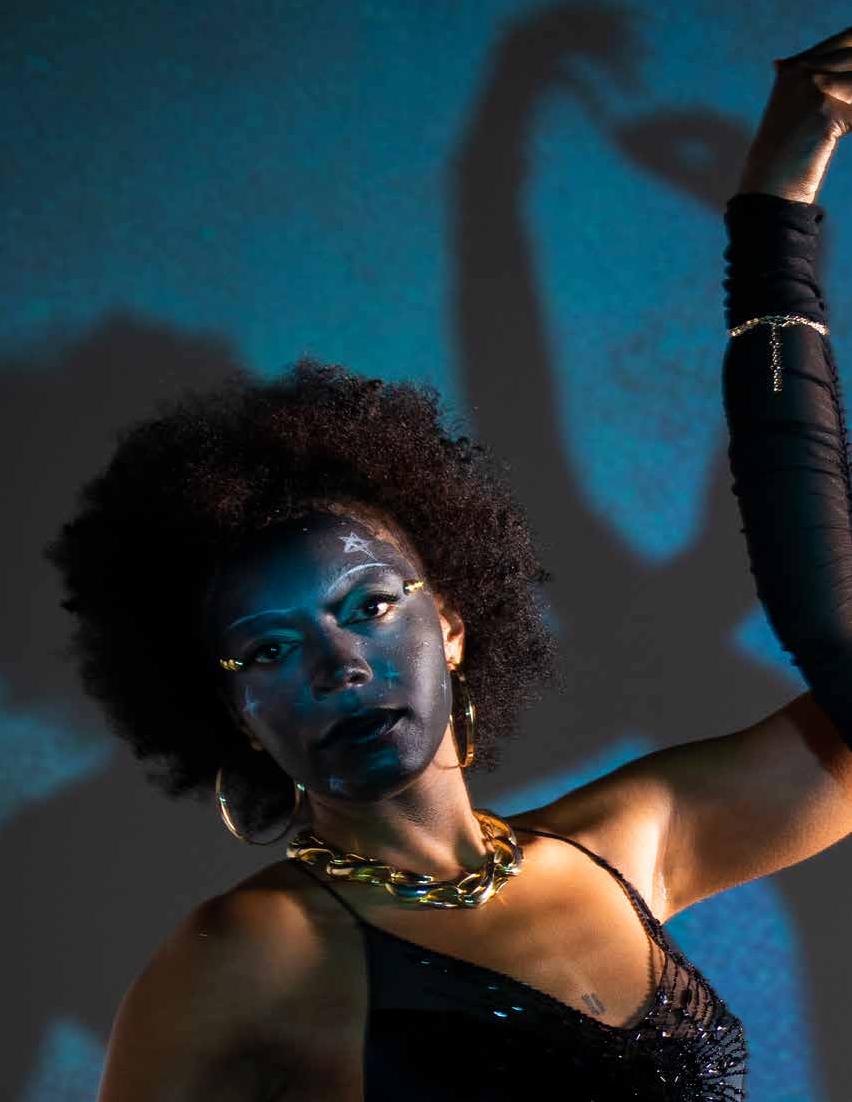
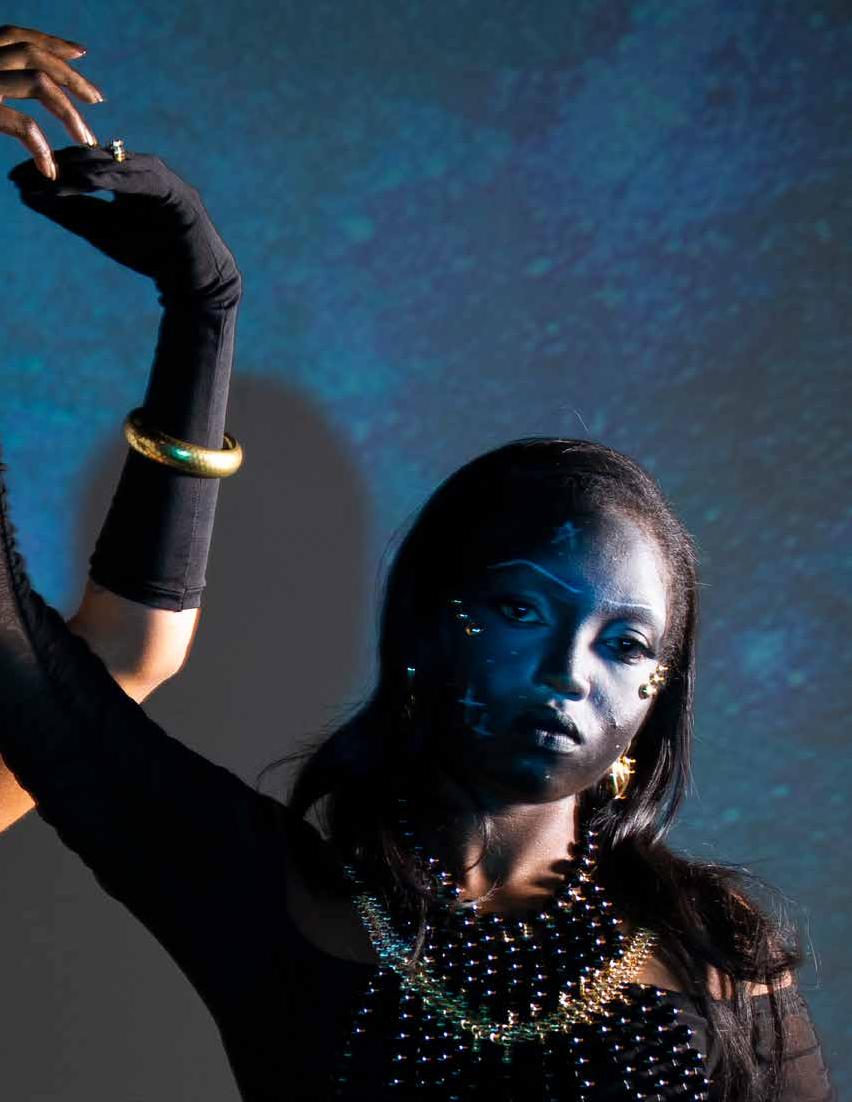






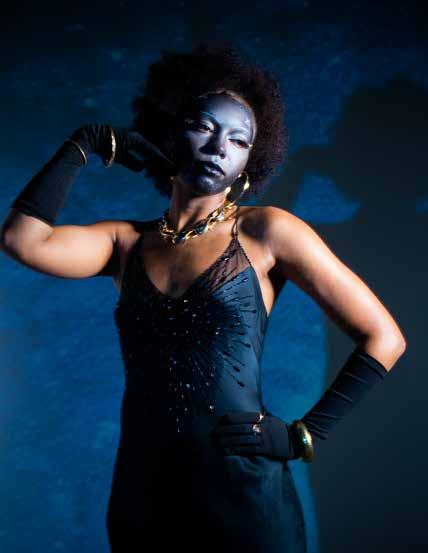





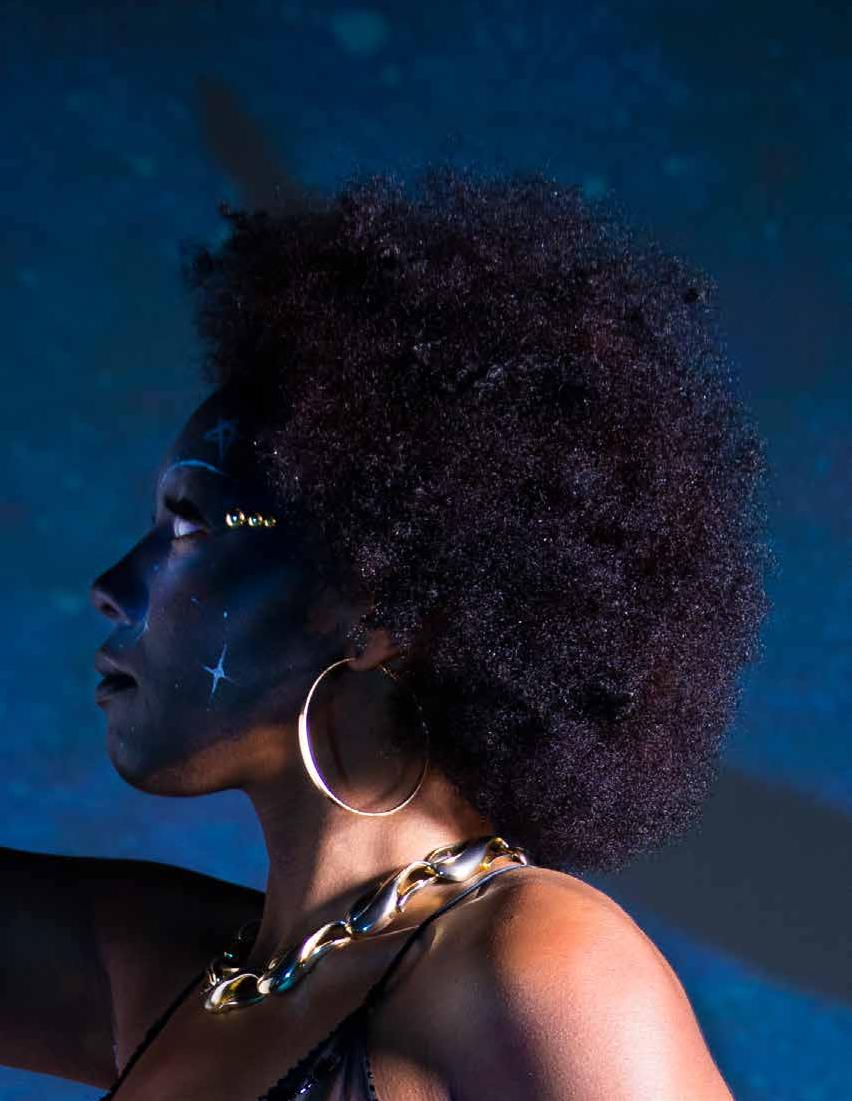


It’s no secret that fashion is housed in one of the most influential spheres of the modern world and has claimed that title for centuries. Much of fashion’s structure stems past trends reappearing or traditional couture taking on a modern spin. However, the lens of the future seems to be vastly unexplored when it comes to the realm of fashion – not necessarily in the means of predicting what will be trending in the next season and how we will affect it but more so how it will affect us.

To ponder past patterns, people have always lived in the world of consumerism. In recent centuries that domain has expanded into what today would best be defned as consumer culture. The act of consumer culture has picked up tremendously after the industrial revolution, and from the 1900s to 2000s, there’s been an all-time high in buying for pleasure. With increased demand for commodities, especially clothing, prices dropped as pieces degraded in quality. As one of the second most polluting industries on earth, the bustling empire of fast fashion often cuts corners. For example, cheap textile dyes can be found polluting clean water on a global scale. Since there’s a large amount of clothes being produced, there’s an equally large amount winding up in the landfll as textile waste.
Consumers are constantly making decisions on what type of buying habits they want to partake in. Although the possibility of choice is involved, the average buyer tends to lean toward inexpensive options, though it usually results in poorer quality clothes that prove unsustainable and shortlived. According to a survey conducted by VoucherCloud, the average American has $550 of unworn clothes, and it’s estimated that Americans throw away 70 pounds of clothes and other textiles per year. In addition,10.5 million tons of clothing end up in American landflls yearly. Clothing like polyester is a synthetic cloth made from plastic. It’s not biodegradable, and will sit in the landfll for anywhere from 20 to 200 years, thus becoming a part of the 85% of textiles that are thrown away instead of recycled or reused.
Companies have immense power over the web that is consumer culture. Up until
the 1940s, children from the ages of six to seven often wore unisex clothing for play. It wasn’t until companies started advertising their clothing as gender specifc that families bought more clothes since it was deemed embarrassing for girls to wear boy’s clothing or vice versa. As time progressed, online shopping fed the fre in urging people to buy more clothes for their closets, even if they didn’t really need it. However, ethical and inexpensive don’t typically walk hand in hand. Workers who are in charge of the material, sewing, packing and labeling—typically in developing countries—are paid a low amount compared to the proft the company makes from selling the clothing in stores.
Although there’s been more accountability on companies via trade unions and wage-tracking across large supply chains, many people are still involved in labor exploitation. Companies such as Zara, Forever 21, Aeropostale, ASOS, GAP, H&M, Nike, Uniqlo, and even Disney’s production of clothing and toys involves child labor or a violation of labor laws. According to the US Department of Labor, a shipment of clothing heading to retailers like Target, Pacsun, Urban Outftters, and more were withheld earlier this year, due to the goods’ violation of the minimum wage, overtime or child labor provisions of the Fair Labor Standards Act. However, there are companies and brands out there that are implementing more sustainable and ethical clothing. Levi’s, Reformation, Boden, Patagonia, Pangea and more are responsibly made and environmentally friendly. Recently, Patagonia’s founder donated the entire company, estimated to be worth around $3 billion, to fght climate change and protect biodiversity.
“The bustling empire of fast fashion often cuts corners.”
The fashion industry has become all consuming, and based on today’s trends it doesn’t appear that it’s slowing down. In recent years, the media has been a huge broadcaster in popularizing the next style or showcasing infuencers adorned in beautiful garments. Fashion is a forward-thinking industry and one of the largest in the world, with consumers and designers alike constantly keeping tabs and buying into whatever is sure to be the next hit. Trends following consumer habits are also closely tied to spending, in turn affecting business models, employment and the consumer culture that surrounds it. Although it’s highly unlikely people will stop buying clothes or interacting with the sphere of fashion, it is likely that the increase of media will bring
more clarity in what they are buying. In recent years sustainability movements and activists protesting poor working conditions have swept across social media platforms in educating and rallying people into a state of awareness concerning where their money is going and what the story behind the clothing on their body really looks like. As people become more informed and familiar with the world of fast fashion there may be less of a pull to buy into brands whose ethical standards aren’t up to par with their own beliefs. With the increase in social media highlighting pros and cons of the fashion industry, society as a whole will hopefully learn to be a better ally to not only the fashion industry but also its workers and environmental resources.
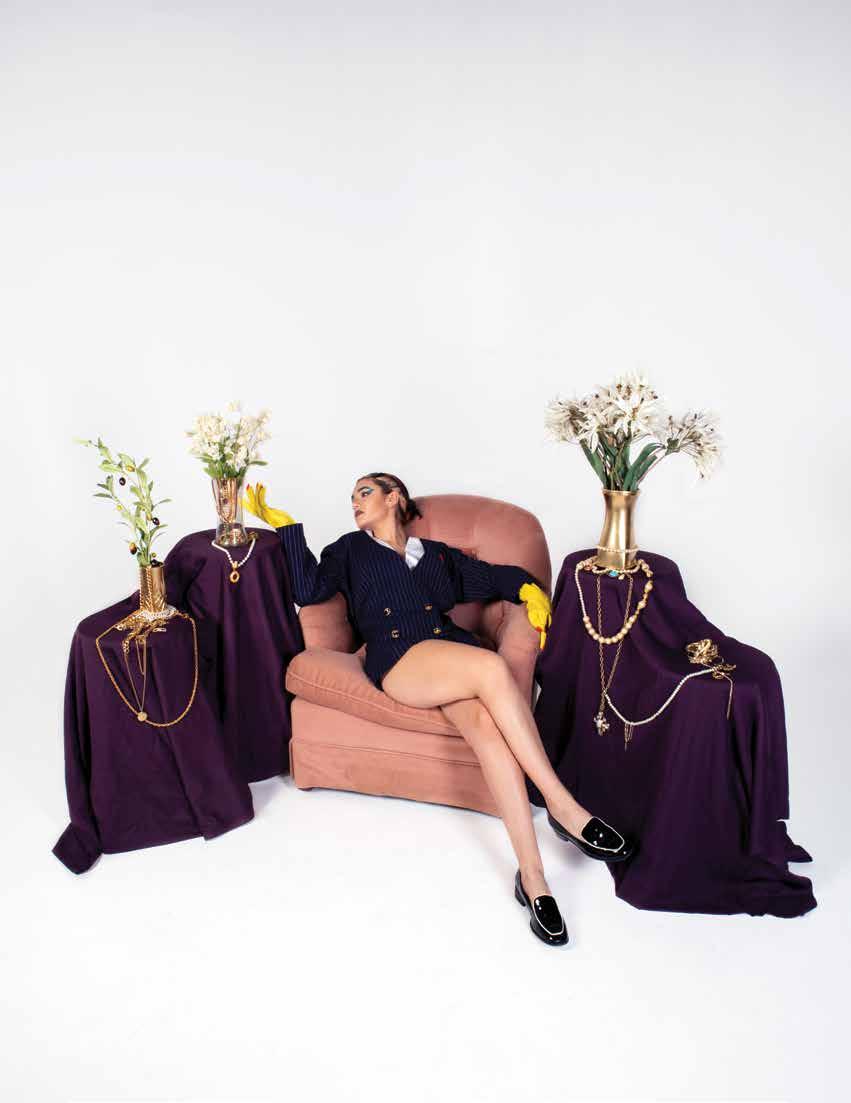
There is a silver lining in our garment-dominated world, and it is possible to help in creating a better world and more conscious lifestyle for both clothing and consumers. By becoming more educated in what companies have good intentions behind their products and implementing that as a consumer, you have the ability to buy into fashion that can be the future of our society. By investing in something that’s not only sustainable and longlasting but environmentally and labor-friendly, we pave a path in creating a new reality for what the scope of fashion can hopefully metamorphosize into.
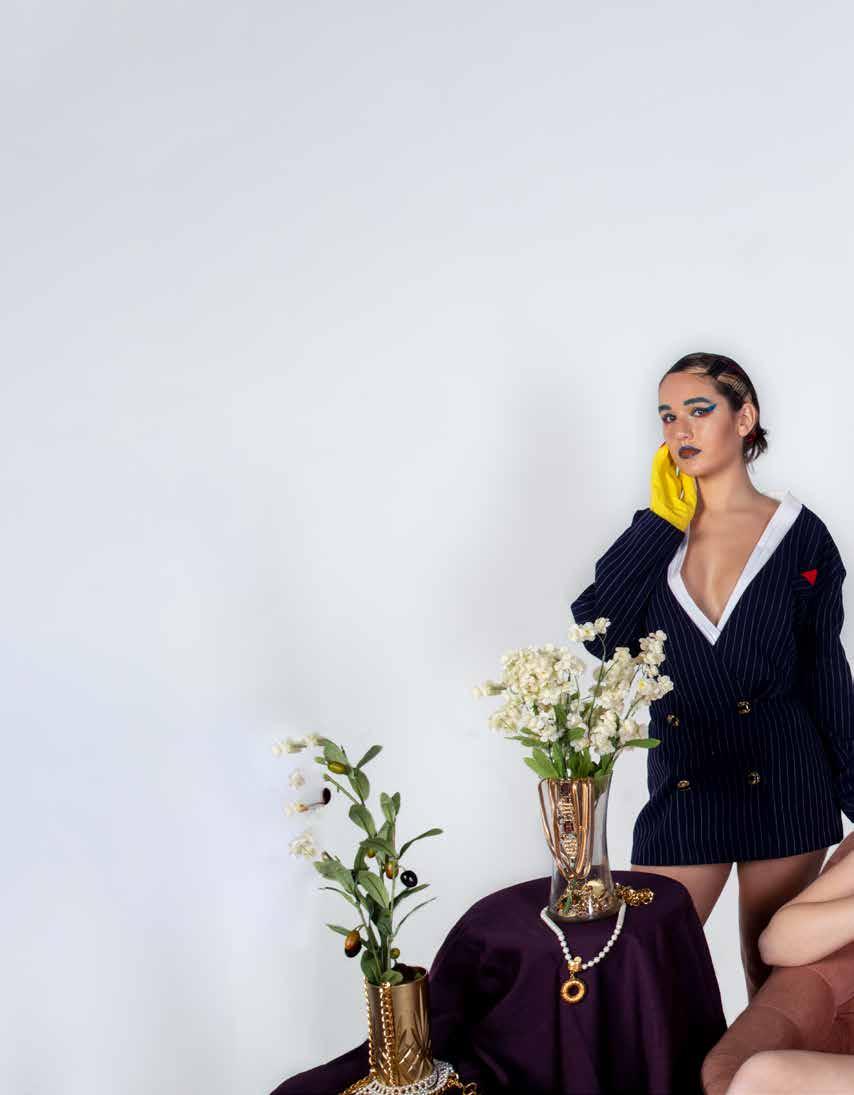
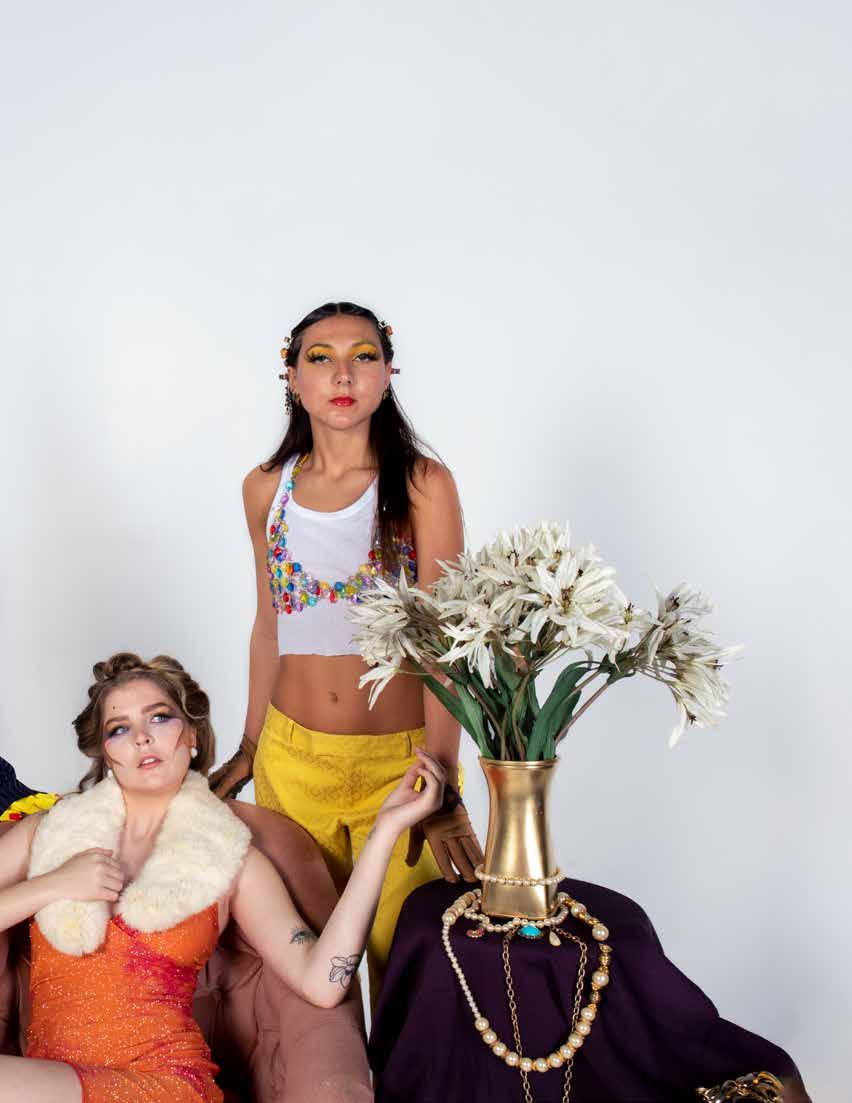
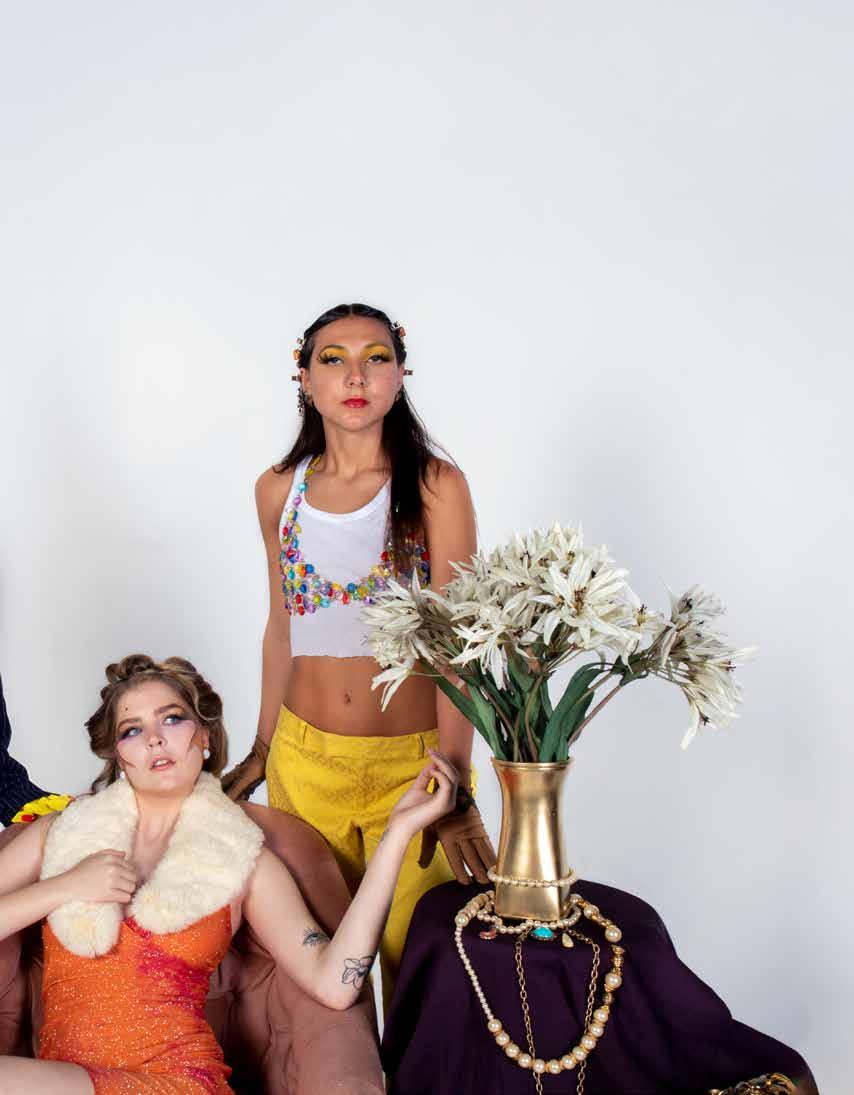

As technology launches forwards and AI advances are becoming the new hit, one starts to wonder where fashion lies in the midst of everything? With virtual, or AI, clothing coming to center stage for everything fashion related, it seems as though fashion is becoming more accessible for everyone. All you have to do is send in images of the poses you want alongside a payment and someone in the AI company will edit the clothes onto your body. High end clothing no longer needs to be purchased at thousands of dollars at a time for people to experience them and show them off to others. They will make the clothes ft your body specifcally, no need to have to pay extra money for alterations or struggle when the pants you want aren’t in your size. It quite literally seems picture perfect with everyone being able to get to wear whatever they want in an environmentally sustainable manner. Yet in all the frenzy, one group has yet again been left out from everyone’s mind.
Disabled people are once again ignored within the fashion space. As AI clothing popped up, disabled communities are fnally getting clothes specifcally made for them. People with sensory issues like autism, adhd, eczema, and psoriasis are now having brands produce clothes with specifc fabrics so it wouldn’t irritate the skin while people with disabilities that caused mobility issues such as cerebral palsy or amputees needed specially modifed clothing to ft their bodies while also being something they didn’t need assistance with. Brands like Zappo’s and Cat and Jack, through Target’s kids section, have adaptive clothing lines for physically disabled people which are great for fnding things such as a single shoe for those with only one foot or pants better suited for those with mobility issues. Other brands such as Bellabu Bear have more sensory friendly options and are popular for having everything from undergarments to pajamas to blankets made of bamboo fber to avoid skin irritation.


With physical fashion fnally moving forwards for disabled people now, it comes as little surprise that clothing for the group is still left behind when AI clothing is moving full speed ahead for able bodied people. Abled people have moved on from the physical fashion in favor of eco-friendly AI clothes that don’t include disabled people. Even though it may appear as though AI fashion would include everyone as it’s meant to adapt to different bodies and you don’t even have to wear it, that is not always the case.
AI fashion can be a great resource to make clothing mockups and samples without wasting materials.
You can even try things on without going to the store and won’t be polluting the environment with fossil fuels if you have to return something that doesn’t ft. Now you can even shop and “wear clothes” with zero pollution whatsoever with AI clothes meant to help you fnd more outfts to help you curate your online persona.
Despite all these amazing opportunities at hand, there are many faws within the lack of accessibility to disabled people. In addition there is the possible fnancial inaccessibility alongside the questionable motive of why we feel the need to make ourselves seem as good as possible on the internet and never repeat clothing items to do so.
On the app DressX, which provides digital clothes, despite having many 5-star reviews, comments still express highly negative opinions such as high prices for digital clothes as well as it looking extremely fake and illftting. One anonymous troubled user writes, “Terrible! Worse then free Snapchat flters!!! Bad idea and terrible execution!! At max each flter should be less than 5 cents! At MAX!!!!”.
Another user left a review stating that, “It’s a cool concept but I was expecting $1-$5 max for each item - not $40-$110!! Why would I pay that much money for ‘clothes’ when I can actually buy the clothes and have them in my closet. ”Anonymous ratings on the app were not the only critical reviews. In an online video where YouTuber Safya Nygaard tried DressX to test AI fashion she explained with one of the pieces that, “I think they botched this one. The hat in particular looks super fake. It looks way too big. It’s not even fully on my head.” Even on an able-bodied person with something as simple as a hat, it was not properly done and did not “ft.” While it has the potential to adapt and change, it is not as accessible as it may seem and is not affordable for everyone either.
Despite not having to pay thousands of dollars on new clothes to be physically produced, users can still expect to drop lots of cash to buy digital clothes that aren’t suitable to wear without disabilities. Imagine the struggle of someone in a wheelchair? Imagine a person with a limb deformity? Technology has unlimited avenues to explore and yet it seems that no one wants to take the route that includes disabled people.
It is important to note that as technology becomes more developed, it could turn into a potentially more sustainable fashion route for everyone so long as companies are willing to put in the effort to make it so.

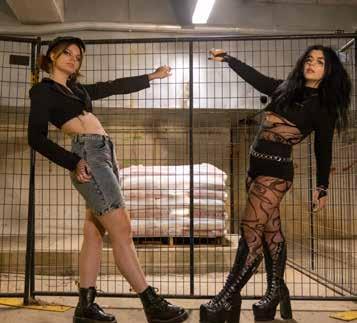


EXPLORE AND YET IT SEEMS THAT NO ONE WANTS TO
TECHNOLOGY HAS UNLIMITED AVENUES TO TAKE THE ROUTE THAT INCLUDES DISABLED PEOPLE.




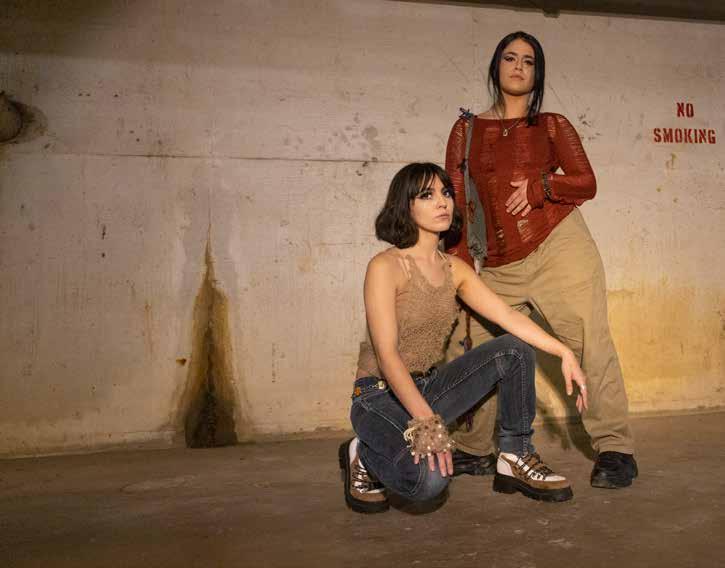
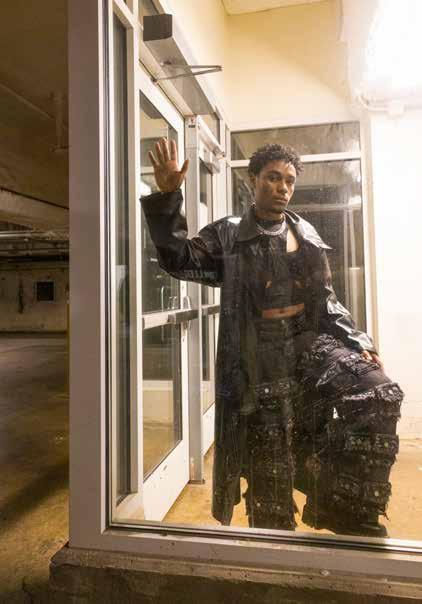
Years ago, in the bedroom of my older sister, I snuck in when no one was home and opened her big mirrored closet doors. I purged her clothes, searching for dresses to try on. One after the other, again and again. I repeated until I had tried on every single dress, looking into the mirror after every one to dance and feel myself. I beamed with joy because I had never felt more confdent than at that moment. It would not be until years later that I started to transition and feel like that almost every day. Fashion played a massive role in my
transition, as it does for many transgender, nonbinary, and gender-nonconforming people or individuals who do not identify with the gender they were frst assigned. Being free to dress how I wanted when transitioning allowed me to express who I am.
Many trans people in the community talk about that feeling of gender euphoria, which is just the opposite of gender dysphoria. Instead of that uneasiness of not feeling like oneself, gender euphoria is a state of bliss and joy that happens when expression aligns with identity. Finding that perfect outft that makes a trans
person feel like themself is euphoric. While clothing being heavily gendered in society causes many problems with the convention of gender norms, it can still be used to convey androgyny.
A method to help ease gender dysphoria for some is surgery; however, not everyone under the transgender umbrella wants surgery to validate their identity. But it is a necessity for a lot of trans people to have that surgery to lessen their gender dysphoria. Before any of us can get those gender-confrming surgeries, there is a whole list of things to do that may take years, not to mention the amount of money it costs for those surgeries. So, while we wait for the ability to have them, a majority of us turn to fashion to express our inner selves. Fashion is an expression of character and personality, and for the trans community, the expression of self is more important than anything.
The fashion industry is slowly entering an era of change. I say “slowly” because trans representation is still rare in the industry, with only a few notable and nationally recognized individuals compared to the many trans models that there are. The reason is that trans people must work harder than the average cisgender person to be recognized as good enough or worthy for the industry. Furthermore, societal acceptance of trans people is growing, but there is still a long way to go for complete acceptance.
In the fashion industry, a lot of work must be done to make it more inclusive. People like Hunter Schafer, Valentina Sampaio, and Laverne Cox are working to pave the way for the future of many trans individuals in the fashion industry and pop culture. Alongside those women, Slay Model Management is breaking all preconceived notions regarding trans models by being a trans talent agency.
I offcially joined Slay as a model this past summer, and I have worked closely with them for the past year. Being a part of a family of beautiful trans individuals is powerful. I can not accurately explain how euphoric it
feels to be surrounded by people who just understand. I have always believed that trans people are the future, mainly because we were all born at a time when we must work incredibly hard to live our authentic lives. We must work harder to ft in, to be accepted, and to be understood. However, this is not a story of confict and victimhood; it is one about resilience, success, and the importance of recognition.
Working with beautiful trans women is empowering. This past summer, I worked out in Los Angeles, California, with 16 other women. One moment specifcally, we were all on stage with Bradley Miller, a transgender activist, and she was giving a speech about her experiences working with us, our identities, and the power of our visibility being on stage in a West Hollywood club. Visibility is the single-handedly most crucial thing leading to our futures in fashion. Miller said we are all on stage, and you can not forget us because now you know many of us. The audience saw us hold our heads high as we all walked with power in our transness; they shall never forget the moment. The audience now knows of many trans women because we are here, visible, and not going anywhere. That moment was incredibly moving for us; we walked off stage, we hugged Miller, and many of us teared up out of joy.
The industry is at a pivotal point in history in which it is trying to transcend past the traditional beauty standards. The industry has taken a progressive stance, allowing for the championing of trans models and contributions to the community’s wvisibility by putting trans models in their rightful place in society. We are here trying to push the industry into the future by simply showing the world that we are beautiful and confdent in who we are.
